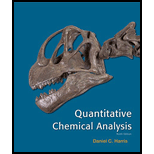
a)
Interpretation:
The working of solid-phase microextraction technique along with the necessity of cold trapping during injection with solid-phase microextraction and also the extraction of an analyte into the fibre in solid-phase micro extraction has to be explained.
Concept Introduction:
Solid-phase microextraction:
The extraction of compounds from liquids, air or sludge without any solvent is called as solid-phase microextraction. The major component is the fused-silica fibre coated with 10-100μm thickness in film of stationary phase exactly to those used in gas chromatography.
The mass of analyte absorbed in the coated fibre is calculated using the formula,
m=KVfc0VsKVf+Vs
Where Vf = volume of film on the fibre
Vs = volume of solution that is extracted
c0 = initial concentration of analyte in the solution that is extracted
K = partition coefficient for solute between film and solution.
Cold trapping:
Cold trapping is one of the alternative method for the condensation of solute in narrow band at the starting of the column.
To explain the working of solid-phase microextraction technique along with the necessity of cold trapping during injection with solid-phase microextraction and also the extraction of an analyte into the fibre in solid-phase microextraction
b)
Interpretation:
The differences between stir-bar sorptive extraction and solid phase microextraction has the explained. The one is which is sensitive and reason has to be given.
Solid-phase microextraction:
The extraction of compounds from liquids, air or sludge without any solvent is called as solid-phase microextraction. The major component is the fused-silica fibre coated with 10-100μm thickness in film of stationary phase exactly to those used in gas chromatography.
The mass of analyte absorbed in the coated fibre is calculated using the formula,
m=KVfc0VsKVf+Vs
Where Vf = volume of film on the fibre
Vs = volume of solution that is extracted
c0 = initial concentration of analyte in the solution that is extracted
K = partition coefficient for solute between film and solution.
Stir-bar sorptive extraction:
Stir-bar asorptive extraction is closely related with solid-phase microextraction but is found to be ∼100 ~times more sensitive for trace analysis.
The mass of analyte that is extracted is given as,
m=KVfc0VsKVf+Vs
Where Vf = volume of film on the fibre
Vs = volume of solution that is extracted
c0 = initial concentration of analyte in the solution that is extracted
K = partition coefficient for solute between film and solution.
But there is raise in the volume of sorbent ( Vf) from ∼0.5μL in solid-phase microextraction to 25-125μL in stir-bar asorptive extraction. Hence, the analyte is 50-250 times more extracted with stir bar.
To explain differences between stir-bar sorptive extraction and solid phase microextraction and to give the most sensitive technique with reason
Want to see the full answer?
Check out a sample textbook solution
Chapter 24 Solutions
Quantitative Chemical Analysis
- Predict the major organic product(s), if any, of the following reactions. Assume all reagents are in excess unless otherwise indicated.arrow_forwardHow many signals would you expect to find in the 1 H NMR spectrum of each given compound? Part 1 of 2 2 Part 2 of 2 HO 5 ☑ Х IIIIII***** §arrow_forwardA carbonyl compound has a molecular ion with a m/z of 86. The mass spectra of this compound also has a base peak with a m/z of 57. Draw the correct structure of this molecule. Drawingarrow_forward
- Can you draw this using Lewis dot structures and full structures in the same way they are so that I can better visualize them and then determine resonance?arrow_forwardSynthesize the following compound from cyclohexanol, ethanol, and any other needed reagentsarrow_forwardFor a titration of 20.00 mL of 0.0500 M H2SO4 with 0.100 M KOH, calculate the pH at each of the following volume of KOH used in the titration: 1) before the titration begin; 2) 10.00 mL; 3) 20.00 mL; 4) 30.00 mL. Ka2 = 1.20×10-2 for H2SO4.arrow_forward
- Curved arrows are used to illustrate the flow of electrons. Using the provided starting and product structures, draw the curved electron-pushing arrows for the following reaction or mechanistic step(s) Be sure to account for all bond-breaking and bond-making steps Problem 73 of 10 Drawing Amows ro HO Donearrow_forward12. Synthesize the following target molecules (TMs) using the specified starting materials. .CI a) HO3S SM TM b) HO- SMarrow_forwardFor a titration of 20.00 mL of 0.0500 M H2SO4 with 0.100 M KOH, calculate the pH at each of the following volume of KOH used in the titration: 1) before the titration begin; 2) 10.00 mL; 3) 20.00 mL; 4) 30.00 mL. Ka2 = 1.20×10-2 for H2SO4.arrow_forward
- Write the systematic name of each organic molecule: structure name show work. don't give Ai generated solutionarrow_forwardShow work with explanation needed. Don't give Ai generated solutionarrow_forwardA Elschboard Part of SpeechT-D Alt Leaming App app.aktiv.com Curved arrows are used to illustrate the flow of electrons. Using the provided resonance structures, draw the curved electron- pushing arrows to show the interconversion between resonance hybrid contributors. Be sure to account for all bond-breaking and bond-making steps. Include all lone pairs and formal charges in the structures. Problem 45 of 10 I Select to Add Arrows N Please selarrow_forward
 ChemistryChemistryISBN:9781305957404Author:Steven S. Zumdahl, Susan A. Zumdahl, Donald J. DeCostePublisher:Cengage Learning
ChemistryChemistryISBN:9781305957404Author:Steven S. Zumdahl, Susan A. Zumdahl, Donald J. DeCostePublisher:Cengage Learning ChemistryChemistryISBN:9781259911156Author:Raymond Chang Dr., Jason Overby ProfessorPublisher:McGraw-Hill Education
ChemistryChemistryISBN:9781259911156Author:Raymond Chang Dr., Jason Overby ProfessorPublisher:McGraw-Hill Education Principles of Instrumental AnalysisChemistryISBN:9781305577213Author:Douglas A. Skoog, F. James Holler, Stanley R. CrouchPublisher:Cengage Learning
Principles of Instrumental AnalysisChemistryISBN:9781305577213Author:Douglas A. Skoog, F. James Holler, Stanley R. CrouchPublisher:Cengage Learning Organic ChemistryChemistryISBN:9780078021558Author:Janice Gorzynski Smith Dr.Publisher:McGraw-Hill Education
Organic ChemistryChemistryISBN:9780078021558Author:Janice Gorzynski Smith Dr.Publisher:McGraw-Hill Education Chemistry: Principles and ReactionsChemistryISBN:9781305079373Author:William L. Masterton, Cecile N. HurleyPublisher:Cengage Learning
Chemistry: Principles and ReactionsChemistryISBN:9781305079373Author:William L. Masterton, Cecile N. HurleyPublisher:Cengage Learning Elementary Principles of Chemical Processes, Bind...ChemistryISBN:9781118431221Author:Richard M. Felder, Ronald W. Rousseau, Lisa G. BullardPublisher:WILEY
Elementary Principles of Chemical Processes, Bind...ChemistryISBN:9781118431221Author:Richard M. Felder, Ronald W. Rousseau, Lisa G. BullardPublisher:WILEY





